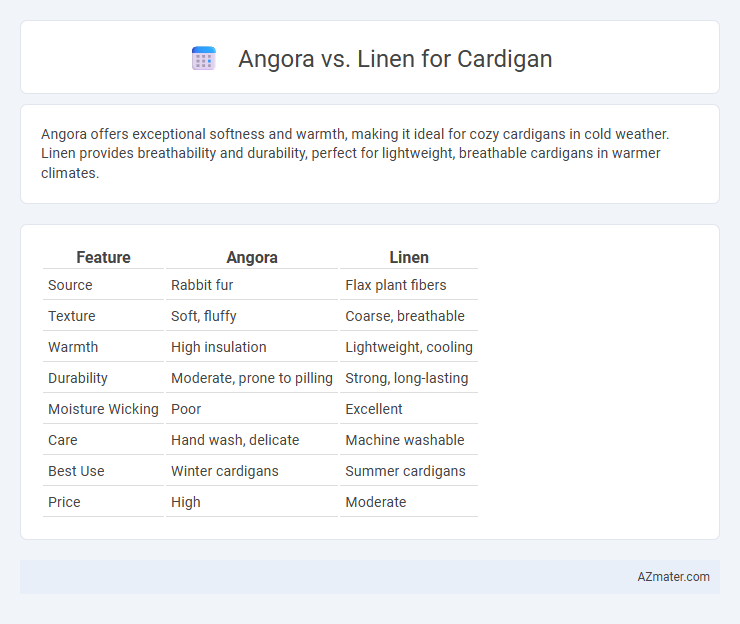Angora offers exceptional softness and warmth, making it ideal for cozy cardigans in cold weather. Linen provides breathability and durability, perfect for lightweight, breathable cardigans in warmer climates.
Table of Comparison
| Feature | Angora | Linen |
|---|---|---|
| Source | Rabbit fur | Flax plant fibers |
| Texture | Soft, fluffy | Coarse, breathable |
| Warmth | High insulation | Lightweight, cooling |
| Durability | Moderate, prone to pilling | Strong, long-lasting |
| Moisture Wicking | Poor | Excellent |
| Care | Hand wash, delicate | Machine washable |
| Best Use | Winter cardigans | Summer cardigans |
| Price | High | Moderate |
Understanding Angora and Linen Fabrics
Angora fabric, derived from the Angora rabbit's soft, fine fibers, offers exceptional warmth, lightweight softness, and a silky texture ideal for cozy cardigans. Linen, made from flax plant fibers, is highly breathable, moisture-wicking, and durable, making it perfect for lightweight, summer-friendly cardigans. Comparing Angora and Linen for cardigans highlights Angora's superior insulation and luxury feel versus Linen's cool comfort and easy care properties.
Key Differences Between Angora and Linen
Angora cardigans are known for their exceptional softness, warmth, and lightweight feel due to the fine fibers from Angora rabbits, whereas linen cardigans offer superior breathability and durability, making them ideal for warmer climates. Angora fibers provide natural insulation and a fluffy texture, while linen has a crisp, textured finish that becomes softer with wear. Maintenance requirements also differ: Angora demands gentle hand washing to preserve its delicate fibers, whereas linen is more robust and can typically be machine washed without significant damage.
Comfort and Softness: Angora vs Linen
Angora fibers offer exceptional warmth and unmatched softness, making cardigans cozy and gentle against the skin. Linen, while breathable and lightweight, tends to have a slightly rougher texture that may feel less soft compared to angora. For ultimate comfort and a plush feel, angora cardigans outperform linen in softness and warmth retention.
Warmth and Breathability Factors
Angora fibers provide exceptional warmth due to their fine, hollow structure that traps heat effectively, making angora cardigans ideal for cold weather. Linen, made from flax fibers, offers superior breathability and moisture-wicking properties, keeping wearers cool and comfortable in warmer temperatures. Choosing between angora and linen for cardigans depends on balancing the need for insulation versus ventilation based on the climate and layering preferences.
Durability and Longevity Comparison
Angora provides exceptional warmth and softness but tends to be less durable and more prone to pilling compared to linen, making it less ideal for high-frequency wear cardigans. Linen, derived from flax fibers, offers superior durability and strength, maintaining its structure and appearance over time, especially in warmer climates. For longevity, linen cardigans withstand regular use and washing better than angora, which requires delicate care to preserve its softness and prevent fiber damage.
Maintenance and Care Requirements
Angora cardigans require delicate maintenance, including gentle hand washing with cold water and specialized wool detergents to prevent fiber damage and matting. Linen cardigans offer easier care with machine washable properties, though they should be laundered in cold water and air-dried to maintain fabric strength and avoid shrinkage. Proper storage for Angora involves moisture control and avoiding direct sunlight to retain softness, while linen benefits from wrinkle-resistant handling and breathable environments.
Environmental Impact and Sustainability
Angora fibers are derived from Angora rabbits and involve ethical concerns due to animal welfare issues, while linen is made from flax plants, offering a renewable and biodegradable resource with minimal water usage and pesticide requirements. Linen production has a lower carbon footprint compared to Angora, which entails intensive animal farming practices contributing to higher greenhouse gas emissions. Choosing linen cardigans supports sustainable fashion by promoting eco-friendly materials that reduce environmental impact and favor circular economy principles.
Style and Versatility in Cardigans
Angora cardigans offer a luxurious, soft texture that exudes elegance and warmth, making them ideal for sophisticated, cozy styles. Linen cardigans provide breathability and a casual, lightweight feel, perfect for layering in warmer weather and achieving a relaxed, versatile look. Both materials enhance cardigan style uniquely: angora for refined, plush outfits and linen for airy, adaptable ensembles suitable for various occasions.
Price and Value for Money
Angora cardigans typically come at a higher price point due to the softness, warmth, and luxury associated with angora fiber, offering excellent insulation and a plush feel. Linen cardigans are more affordable, breathable, and lightweight, ideal for warmer climates but less insulating than angora. When evaluating value for money, angora provides superior warmth and a premium texture worth the investment for cold seasons, while linen excels in affordability and comfort during mild to hot weather.
Choosing the Right Fabric for Your Cardigan
Angora offers exceptional warmth and softness, ideal for cozy cardigans that provide lightweight insulation in cooler weather. Linen, known for its breathability and moisture-wicking properties, suits cardigans designed for warmer climates or layering in transitional seasons. When choosing between Angora and Linen for your cardigan, consider the fabric's thermal regulation, durability, and maintenance requirements to match your lifestyle and climate needs.

Infographic: Angora vs Linen for Cardigan
 azmater.com
azmater.com